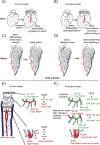Veins and Arteries Build Hierarchical Branching Patterns Differently: Bottom-Up versus Top-Down
- PMID: 30805984
- PMCID: PMC6478158
- DOI: 10.1002/bies.201800198
Veins and Arteries Build Hierarchical Branching Patterns Differently: Bottom-Up versus Top-Down
Abstract
A tree-like hierarchical branching structure is present in many biological systems, such as the kidney, lung, mammary gland, and blood vessels. Most of these organs form through branching morphogenesis, where outward growth results in smaller and smaller branches. However, the blood vasculature is unique in that it exists as two trees (arterial and venous) connected at their tips. Obtaining this organization might therefore require unique developmental mechanisms. As reviewed here, recent data indicate that arterial trees often form in reverse order. Accordingly, initial arterial endothelial cell differentiation occurs outside of arterial vessels. These pre-artery cells then build trees by following a migratory path from smaller into larger arteries, a process guided by the forces imparted by blood flow. Thus, in comparison to other branched organs, arteries can obtain their structure through inward growth and coalescence. Here, new information on the underlying mechanisms is discussed, and how defects can lead to pathologies, such as hypoplastic arteries and arteriovenous malformations.
Keywords: angiogenesis; arteries; blood flow; branching morphogenesis; coronary vasculature; cxcr4; notch; vein.
© 2019 WILEY Periodicals, Inc.
Figures




Similar articles
-
Making vascular networks in the adult: branching morphogenesis without a roadmap.Trends Cell Biol. 2003 Mar;13(3):131-6. doi: 10.1016/s0962-8924(03)00022-9. Trends Cell Biol. 2003. PMID: 12628345 Review.
-
Blood flow-induced Notch activation and endothelial migration enable vascular remodeling in zebrafish embryos.Nat Commun. 2018 Dec 14;9(1):5314. doi: 10.1038/s41467-018-07732-7. Nat Commun. 2018. PMID: 30552331 Free PMC article.
-
During vertebrate development, arteries exert a morphological control over the venous pattern through physical factors.Phys Rev E Stat Nonlin Soft Matter Phys. 2008 May;77(5 Pt 1):051912. doi: 10.1103/PhysRevE.77.051912. Epub 2008 May 15. Phys Rev E Stat Nonlin Soft Matter Phys. 2008. PMID: 18643107
-
Notch signaling in vascular morphogenesis.Curr Opin Hematol. 2004 Jul;11(4):278-83. doi: 10.1097/01.moh.0000130309.44976.ad. Curr Opin Hematol. 2004. PMID: 15314528 Review.
-
Functional arterial and venous fate is determined by graded VEGF signaling and notch status during embryonic stem cell differentiation.Arterioscler Thromb Vasc Biol. 2007 Mar;27(3):487-93. doi: 10.1161/01.ATV.0000255990.91805.6d. Epub 2006 Dec 21. Arterioscler Thromb Vasc Biol. 2007. PMID: 17185616
Cited by
-
Endothelial cell transitions in zebrafish vascular development.Dev Growth Differ. 2024 Aug;66(6):357-368. doi: 10.1111/dgd.12938. Epub 2024 Jul 27. Dev Growth Differ. 2024. PMID: 39072708 Free PMC article. Review.
-
Developmental Perspectives on Arterial Fate Specification.Front Cell Dev Biol. 2021 Jun 25;9:691335. doi: 10.3389/fcell.2021.691335. eCollection 2021. Front Cell Dev Biol. 2021. PMID: 34249941 Free PMC article. Review.
-
Selective and Marked Blockade of Endothelial Sprouting Behavior Using Paclitaxel and Related Pharmacologic Agents.Am J Pathol. 2021 Dec;191(12):2245-2264. doi: 10.1016/j.ajpath.2021.08.017. Epub 2021 Sep 24. Am J Pathol. 2021. PMID: 34563512 Free PMC article.
-
Remodeling of the Microvasculature: May the Blood Flow Be With You.Front Physiol. 2020 Oct 15;11:586852. doi: 10.3389/fphys.2020.586852. eCollection 2020. Front Physiol. 2020. PMID: 33178049 Free PMC article. Review.
-
ETS factors are required but not sufficient for specific patterns of enhancer activity in different endothelial subtypes.Dev Biol. 2021 May;473:1-14. doi: 10.1016/j.ydbio.2021.01.002. Epub 2021 Jan 14. Dev Biol. 2021. PMID: 33453264 Free PMC article.
References
Publication types
MeSH terms
Substances
Grants and funding
LinkOut - more resources
Full Text Sources
Research Materials

